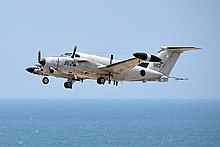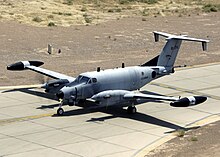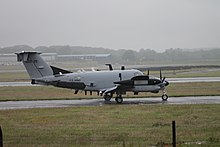Beechcraft RC-12 Guardrail
| RC-12 Guardrail | |
|---|---|

| |
| RC-12N | |
| Role | Signals intelligenceaircraft |
| Manufacturer | Beechcraft |
| Introduction | 1983 |
| Status | Active service |
| Primary user | United States Army |
| Developed from | Beechcraft C-12 Huron |
TheBeechcraft RC-12 Guardrailis an airbornesignals intelligence(SIGINT) collection platform based on theBeechcraft King AirandSuper King Air.While the US military and specifically theUnited States Armyhave numerous personnel transport variants of the King Air platforms referred to with the generalC-12designation, the RC-12 specification refers to a heavily modified platform that collects SIGINT through various sensors and onboard processors.
Design and development[edit]
TheUS ArmyGuardrail platform has been in service since 1971.[1]Prior to the early 1980s, the early Guardrail variants were based on theU-21.After adopting the C-12 platform over the U-21, the Guardrail platform has received structural, power plant, and equipment upgrades as noted by the various models described below.
Initially, the US Army had 13 RC-12Ds converted fromC-12Ds,with deliveries starting in mid-1983. One aircraft was assigned to US Army Forces Command (FORSCOM) atFort McPherson,Georgia, and the remainder to the1st Military Intelligence Battalionat Wiesbaden, Germany, and the2nd Military Intelligence Battalionat Stuttgart, Germany. The German-based aircraft were re-assigned in late 1991 to 3rd, 15th and 304th Military Intelligence Battalions atCamp Humphreys(South Korea),Fort Hood(Texas) andFort Huachuca(Arizona) respectively. One was converted back to an earlier configuration as C-12D-1.[2]
The next model was the RC-12G. Three RC-12G were delivered in 1985 after conversion from C-12D airframes. These aircraft served in Latin America and then with the 138th Military Intelligence Company (Aerial Exploitation) in Orlando, Florida, before being moved into storage atFort Sill,Oklahoma.[2]
After the RC-12G, the next model was the RC-12H. The initial system contractor ESL Inc. delivered 6 RC-12H in 1988 for the 3rd Military Intelligence Battalion at Camp Humphreys in Pyongtaek, South Korea.[2]

The next model was the RC-12K, after the RC-12H. The US Army ordered nine RC-12Ks in October 1985, of which eight replaced RC-12Ds in the 1st Military Intelligence Battalion in May 1991. One of these was lost in an accident. The ninth US Army aircraft was retained by the contractor, Raytheon, for conversion to the planned RC-12N configuration. An additional 2 RC-12K aircraft were delivered to Israel in May–June 1991.[2]
The prototype RC-12N was converted from an RC-12K. A total of 15 were converted by E-Systems and delivered 1992-93 to the 224th Military Intelligence Battalion atHunter Army Airfield,Georgia and the 304th Military Intelligence Battalion at Libby Army Airfield, Fort Huachuca, Arizona. One of these was lost in accident.[2]
These led to the next model, the RC-12P. A total of 9 RC-12P aircraft were delivered to ESL/TRW atMoffett Federal Airfieldin late 1994 and 1995. These airframes remained there in 1999.[2]
Three RC-12Ps were then modified by Raytheon and TRW to become RC-12Q. They were transferred to TRW in 1996 for outfitting, where they remained in 1999. The aircraft featured a prominent dorsal radome housing a satellite communications antenna.[2]
The RC-12 in various versions to include the newest RC-12X and RC-12X+ have seen deployments toOperation Enduring FreedomandOperation Iraqi Freedom.As of July 2012,Northrop Grummanannounced that its RC-12X Guardrails had completed over 1,000 missions since going into theatre in 2011.[3]Recent upgrades and force realignments have seen these newest models replace older variants in Korea.
A 2017 $462 million RC-12X program,[4]by Northrop Grumman, will upgrade all aircraft in the Army's RC-12 fleet to the RC-12X standard, replacing or upgrading all older variants. The Guardrail Modernization program extends the life of the aircraft to 2025 and introduces new payloads to the system with enhanced capabilities. The program enhances the sustainability of the RC-12X through commonality, a new glass cockpit, structural upgrades, and significant hardware and software improvements.[5]
Description[edit]
The newest Guardrail variant, the Guardrail Common Sensor (GR/CS), also called the RC-12X or RC-12X+, is a "fixed-wing, airborne, SIGINT-collection and precision targeting location system. It collects low-, mid- and high-band radio signals andELINTsignals, identifies and classifies them, determines source location, and provides near-real-time reporting. GR/CS uses a Guardrail Mission Operations Facility (MOF) for the control, data processing and message center for the system.”[6]
Variants[edit]
- TheRC-12Daircraft used in the Improved Guardrail V system were based on the King Air Model A200CT. This US Army Special Electronic Mission version carried the AN/USD-9 Improved Guardrail V remote-controlled communications intercept and direction-finding system. Associated ground equipment included the AN/TSQ-105(V)4 integrated processing facility, AN/ARM-63(V)4 AGE flightline van and AN/TSC-87 tactical commander's terminal. Five new-build RC-12D-like aircraft were sold to Israel for 191 Squadron atSde Dov.These aircraft were referred to either as RC-12D-FW or FWC-12D, with the FW reportedly being an abbreviation for "Field Wind," possibly a codeword for Israeli specific equipment fitted to the aircraft. The codeword "Big Apple" was related to these aircraft.[2]
- TheRC-12G,used for the Crazy Horse system, was a US Army Special Electronic Mission aircraft based on the King Air A200CT. Generally similar to RC-12D, the maximum takeoff weight was increased to 6,800 kilograms (15,000 pounds).[2]
- TheRC-12Haircraft used for Guardrail/Common Sensor System 3 (Minus) was a US Army Special Electronic Mission aircraft that was generally similar to the RC-12D, though with the maximum takeoff weight increased to 6,800 kilograms (15,000 pounds).[2]
- TheRC-12Kaircraft used for Guardrail/Common Sensor System 4 was similar to RC-12H, but with a more powerful 1,100 shp (820 kW) PT6A-67 turboprop engine and a maximum takeoff weight increased to 7,250 kilograms (16,000 pounds).[2]
- TheRC-12Naircraft used in Guardrail/Common Sensor System 1 was generally similar to the RC-12K, though with a 7,350 kilogram (16,200 pound) maximum takeoff weight, and equipped with dual EFIS and aircraft survivability equipment/avionics control system (ASE/ACS). The prototype RC-12N was converted from an RC-12K.[2]

- TheRC-12Paircraft used in Guardrail/Common Sensor System 2 had the same avionics and power plant as the RC-12N, though with different mission equipment (including datalink capability), fibre optic cabling, and smaller and lighter wing pods. The maximum takeoff weight was increased to 7,480 kilograms (16,500 pounds).[2]
- TheRC-12Qaircraft, referred to as the Direct Air Satellite Relay, consisted of 3 RC-12Ps modified by Raytheon and TRW to act as 'mother ships' to expand the RC-12P's operational area outside satellite 'footprints.' The airframes were transferred to TRW in 1996 for outfitting, where they remained in 1999. The aircraft featured a prominent dorsal radome housing a satellite communications antenna.[2]
- TheRC-12Xaircraft was a further improved RC-12 for use with the GRCS, which included expanded frequency ranges, a capability to locate signals in both stand-off and stand-in modes, and an adaptive beam-forming antenna array that is capable of locating emitters in the dense signal environments.[2]
- TheRC-12X+was a further improvement on the RC-12X and represents the latest variant of the system currently fielded as of 2016.[7]
Incidents and accidents[edit]
On 16 April 1997, the 224th Military Intelligence Battalion lost an RC-12N and 2 crew members in a fatal training accident. The following year on 6 November 1998, the 1st Military Intelligence Battalion lost a RC-12K and 2 crew members in a similar training accident.
In both accidents, the United States Army Safety Center Accident Boards listed in their recommendations to TRADOC to 'Re-evaluate the ATM Tasks for stalls, slow flight and VMC.' In February 1999, Commanding General, USAIC and FH, Major General John D. Thomas, sent a senior standardization instructor pilot and the 305th Military Intelligence Battalion Safety Officer to USAAVNC to review the RC-12K Accident Board findings to determine if training was a contributing factor. They recommended to Major General Thomas that the TC 1-219,Tasks for Slow Flight, Stalls and VMC,be rewritten.[2]
Specifications (RC-12H)[edit]

Data fromoperating manual[8]
General characteristics
- Length:43 ft 9 in (13.34 m)
- Wingspan:58 ft 6 in (17.83 m)
- Height:14 ft 8 in (4.47 m)
- Empty weight:11,500 lb (5,216 kg) (zero fuel weight)
- Gross weight:15,090 lb (6,845 kg)
- Max takeoff weight:15,000 lb (6,804 kg)
- Powerplant:2 ×Pratt & Whitney Canada PT6A-41turbopropengines, 850 shp (630 kW) each
- Propellers:3-bladed constant-speed propellers
Performance
See also[edit]
Related development
References[edit]
- ^"Guardrail – RC-12X".Northrop Grumman.Retrieved3 July2017.
- ^abcdefghijklmnopPike, John."RC-12 Huron Special Electronic Mission Aircraft".globalsecurity.org.Retrieved3 July2017.
- ^"The USAs RC-12X Guardrail SIGINT Modernization".Defense Industry Daily.Retrieved3 July2017.
- ^"Northrop Grumman Wins $750M Contract to Perform Upgrades, Modernization and Integration on the US Army's Fixed Wing Airborne ISR Fleet".Northrop Grumman Newsroom.Retrieved23 March2022.
- ^"U.S. Army to Fields RC-12X SIGINT Aircraft | Defense Update".defense-update.14 February 2011.Retrieved3 July2017.
- ^"Guardrail Common Sensor (GR/CS)".USAASC.Archived fromthe originalon 15 March 2022.Retrieved3 July2017.
- ^"Army issues RFI for ELINT on Guardrail RC-12X+".Intelligence Community News.6 May 2015.Retrieved4 July2017.
- ^"Operator's Manual for Army RC-12H Aircraft".Google books.Headquarters, Department of the Army. 9 March 1991.Retrieved8 January2023.
External links[edit]
- US Army Official GR/CS Platform Page:http://asc.army.mil/web/portfolio-item/guardrail-common-sensor-grcs/Archived15 March 2022 at theWayback Machine
| Thisaircraftarticle is missing some (or all) of itsspecifications.If you have a source, you can help Wikipedia byadding them. |
